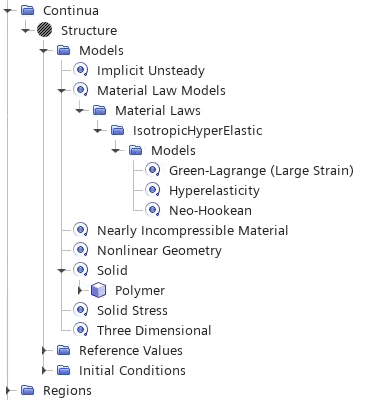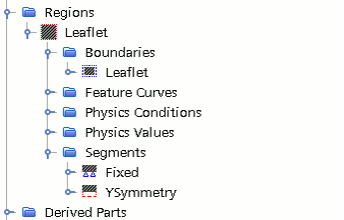Loading the Initial Simulation
As this tutorial is focused on providing adequate time-step resolution, the starting file contains the relevant physics continuum, a partially defined region including some constraints, essential reports, and a local coordinate system.
- Launch Simcenter STAR-CCM+.
- Select
- In the Load Simulation dialog, click Browse...
- In the Open dialog, navigate to the solidStress folder of the downloaded tutorial files.
- Select trileafletValve_start.sim then click Open.
- In the Load Simulation dialog, click OK.
- Save the simulation as trileafletValve.sim.
-
You can review the predefined settings by expanding the relevant nodes.
- Physics Continua
- The simulation requires a single solid
physics continuum. This continuum contains the necessary models for
computing solid stress on an isotropic hyperelastic polymer using
the Neo-Hookean hyperelastic material laws. Nonlinear geometry is
active in the continuum.

- Leaflet Region including Segments
- The starting file contains a single solid
region to represent the leaflets. This single region contains a wall
boundary that represents all the leaflet geometry. The region also
contains two surface segments that each apply a constraint on the
structure:
- Fixed — Prevents the movement of the leaflet edge.
- YSymmetry — Prevents the displacement of the leaflet symmetry surface in the Y direction. This ensures that the plane of symmetry on the X-Z plane of the global coordinate system is maintained.

- Reports
- To define specific properties within the
simulation three different reports are provided:
- CycleTime — calculates the cycle time as a function of the period and the simulation time.
- Leaflet Thickness — defines the overall thickness of the leaflet material (0.4 mm) [994].
- Period — defines the time period of one pressure cycle (0.861 seconds) [995].

- Local Coordinate System
- To define the second symmetry plane in the
model, a local coordinate system has been defined. This local
coordinate system is produced by rotating the global coordinate
system by -30 degrees with respect to the Z axis.
